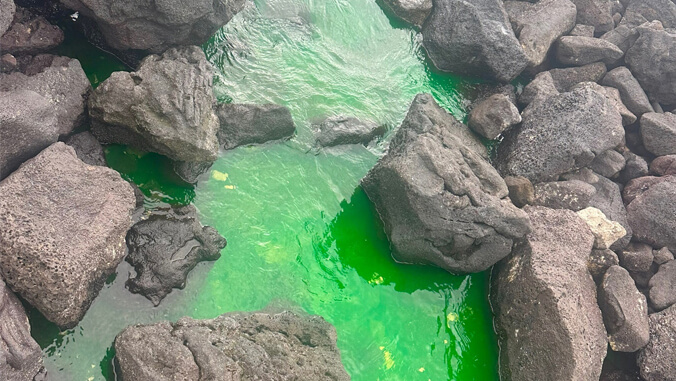
Marine scientists from the University of Hawaiʻi at Hilo conducted an eye-catching experiment on August 9, along the coastline of Kahaluʻu Bay, just south of Kailua-Kona. The team introduced a small amount of fluorescein dye, which glows bright green under sunlight, into a local residence’s sewage disposal system. This test was designed to track whether the dye would reach the shoreline and, if so, how quickly.
- Related UH News story: Rising public risk of infection at Hilo Bay linked to climate change, August 12, 2024
“Sure enough, the dye emerged at a shoreline spring, telling us that the wastewater from at least one home, and possibly more, is flowing out into Kahaluʻu Bay,” said Steve Colbert, a UH Hilo marine science professor who is leading the study.
Kahaluʻu Bay is home to a unique coral reef ecosystem and is also one of the state’s most popular snorkeling locations. According to the County of Hawaiʻi, more than 400,000 people visit the shallow, nearshore reef each year to view its diverse marine life, colorful fish and coral colonies.
Faster flow rate

UH Hilo researchers said what surprised them the most during the testing was how fast the groundwater was carrying sewage to the shoreline.
“We measured groundwater flow rates of 304 yards per day,” said Colbert. “So for homes with cesspools near Aliʻi Drive, sewage can reach the shoreline in less than six hours. Put another way, a toilet flush at high tide may be at the shoreline by the next low tide.”
Colbert noted this is faster than any flow rate the researchers have measured in Keaukaha, Hilo, and twice as fast as the fastest flow at Puakō.
Rising sea levels
The research team included UH Hilo graduate student Ihilani Kamau, who is studying how rising sea levels due to global warming will affect sewer infrastructure and water quality in Kailua-Kona.
“Another purpose is to document and identify sewage pollution hotspots along the Kailua-Kona shoreline and determine which onsite sewage disposal systems and wastewater treatment infrastructures will be affected by sea level rise,” said Kamau who is in the tropical conservation biology and environmental science graduate program.
Research at Kahaluʻu Beach Park is a part of a larger project funded by the Pacific Islands Climate Adaptation Science Center, which is a collaboration between UH Hilo, UH Mānoa and the U.S. Geological Survey.
For more go to UH Hilo Stories.
—By Susan Enright

